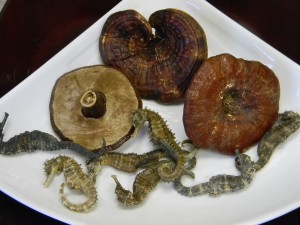![]()
 Enlarged prostate and prostatitis are very common diseases that occur in old male patients. Generally, these diseases are considered to be associated with general aging, weakening of the body energy and the disturbance of sexual hormones. Prostatitis is also caused by pathogenic invasion such as bacteria or virushe main manifestations are dribbling of the urine and difficulty of urination, pain, burning during urination, dark urine, pus, blood, or strong odor. The pulse is often rapid.
Enlarged prostate and prostatitis are very common diseases that occur in old male patients. Generally, these diseases are considered to be associated with general aging, weakening of the body energy and the disturbance of sexual hormones. Prostatitis is also caused by pathogenic invasion such as bacteria or virushe main manifestations are dribbling of the urine and difficulty of urination, pain, burning during urination, dark urine, pus, blood, or strong odor. The pulse is often rapid.
People with prostatitis may as well experience the low back weakness, low sexual desire, feeling cold or tired. It is treated with the herbs which are normally used for infections and inflammations. They clear the heat and clean the toxins.
Main Points of Diagnosis
1. It occurs mostly in aged men who are over 50.
2. Symptoms:
1) Frequent Urination: This is a symptom at the early stage of the disease. Gradually, the frequency of urination increases, which is obvious especially at night. In mild cases the urination will happen 4-5 times a night and in serious cases it may occur dozens of times.
2) Difficulty in Urination: At the beginning, the patient has to wait for a while before urination. Later on, the obstructional condition becomes more serious, accompanied with difficulty in urination or even dribbling in urination.
3) Acute Uroschesis (suppression and/or retention of urine): This symptom is due to factors such as constipation, cold, alcoholic drinking and weariness which can cause hyperemia of the neck of the urinary bladder. Complete obstruction may be formed and acute uroschesis will result.
4) Urinary Incontinence: When the filling of the urinary bladder reaches an extreme state and the intravesical pressure becomes higher than the resistance of the sphincter muscle of urethra, urine will dribble out continuously from the urethra. This phenomenon is called pseudo-uroschesis.
5) Hematuria (presence of blood in urine): Because of the hyperemia of the neck of urinary bladder, sometimes, hematuria may be found under microscopy or even by gross inspection.
6) Complications: On the one hand, urinary obstruction for a long time may lead to other sicknesses like decrease of renal functions or even renal failure, manifested as loss of appetite, fatigue, then nausea and vomiting, hypertension and anemia, Finally, a coma will follow. On the other hand, a long term difficulty in urination may also cause the increase of the abdominal pressure and produce inguinal hernia, hemorrhoid, varicose vein in the lower limbs and so on.
3. Examination
1) Digital Examination of Rectum: Prior to the examination, the contents in the urinary bladder should be entirely cleared out. The examination often shows that the prostate gland is larger than usual but its surface is smooth with no nodes on it. Its edge is distinct and the hardness is medium with resilience. The central sulcus becomes shallow or disappears.
2)Residual Urinary Test: The residual urine is the amount of remaining urine which is collected by urethal catheterization immediately after urination.
3) Cystoscopy and Cystography: If the middle lobe of the prostate increases in size, it is necessary to go through cystoscopy and cystography in order to confirm the diagnosis.
4)Ultrasonic Examination: This examination will show the volume, form and internal structure of the prostate gland.
5) Laboratory examination: Through routine uroscopy, pus cells or red blood cells may be found. Prolonged urinary retention may influence the function of the kidney. Therefore, a further test of urea nitrogen and creatinine will be required.
Differentiation and Treatment of Common Syndromes
1) Damp-Heat Type
Main Symptoms and Signs: The usual manifestations are dribbling urination, frequent urination, burning feeling, difficulty and pain in urination, scanty dark yellowish urine, fullness of the lower abdomen, dry mouth, constipation and fever. Other symptoms and signs are red tongue with yellow greasy fur, taut and rapid pulse.
Therapeutic Principle: Clearing away pathogenic heat and dampness, removing blood stasis and activating the stuffy urethra.
2) Kidney-Deficiency Type
Main Symptoms and Signs: The urination is blocked up or dribbling and hard-going. Other features are pale complexion, an aching pain at the waist, aversion to cold, weariness and fatigue, pale tongue with thin whitish fur, deep and thready pulse.
Therapeutic Principle: Warming and reinforcing the kidney and promoting diuresis.
